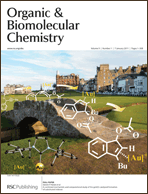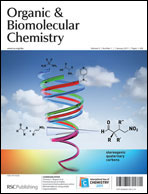This month sees the following articles in OBC that are in the top ten most accessed:-
Regioselective Syntheses of Fully-Substituted 1,2,3-Triazoles: The CuAAC/C–H Bond Functionalization Nexus
Lutz Ackermann and Harish Kumar Potukuchi
Org. Biomol. Chem., 2010, 8, 4503-4513, DOI: 10.1039/C0OB00212G, Perspective
Practical access to highly enantioenriched quaternary carbon Michael adducts using simple organocatalysts
Thomas C. Nugent, Mohammad Shoaib and Amna Shoaib
Org. Biomol. Chem., 2011, Advance Article, DOI: 10.1039/C0OB00822B, Communication
Microwave and flow syntheses of Pseudomonas quinolone signal (PQS) and analogues
James T. Hodgkinson, Warren R. J. D. Galloway, Shreya Saraf, Ian R. Baxendale, Steven V. Ley, Mark Ladlow, Martin Welch and David R. Spring
Org. Biomol. Chem., 2011, Advance Article, DOI: 10.1039/C0OB00652A, Communication
Discovery of a quorum sensing modulator pharmacophore by 3D small-molecule microarray screening
David M. Marsden, Rebecca L. Nicholson, Mette E. Skindersoe, Warren R. J. D. Galloway, Hannah F. Sore, Michael Givskov, George P. C. Salmond, Mark Ladlow, Martin Welch and David R. Spring
Org. Biomol. Chem., 2010, 8, 5313-5323, DOI: 10.1039/C0OB00300J, Paper
Efficient conversion of triacylglycerols and fatty acids to biodiesel in a microwave reactor using metal triflate catalysts
Aaron M. Socha and Jason K. Sello
Org. Biomol. Chem., 2010, 8, 4753-4756, DOI: 10.1039/C0OB00014K, Paper
A new building block for anion supramolecular chemistry. Study of carbazolocarbazole as anion receptor
David Curiel, Miriam Más-Montoya, Guzmán Sánchez, Raúl A. Orenes, Pedro Molina and Alberto Tárraga
Org. Biomol. Chem., 2010, 8, 4811-4814, DOI: 10.1039/C0OB00522C, Communication
Rational design of visible and NIR distyryl-BODIPY dyes from a novel fluorinated platform
Olivier Galangau, Cécile Dumas-Verdes, Rachel Méallet-Renault and Gilles Clavier
Org. Biomol. Chem., 2010, 8, 4546-4553, DOI: 10.1039/C004812G, Paper
Highly sensitive and selective colorimetric and off-on fluorescent probe for Cu2+ based on rhodamine derivative
Chunwei Yu, Jun Zhang, Rui Wang and Lingxin Chen
Org. Biomol. Chem., 2010, 8, 5277-5279, DOI: 10.1039/C0OB00553C, Communication
Chiral Brønsted Acid Catalyzed Asymmetric Friedel-Crafts Alkylation Reaction of Indoles with a,b-Unsaturated Ketones: Short Access to Optically Active 2- and 3-Substituted Indole
Tsubasa Sakamoto, Junji Itoh, Keiji Mori and Takahiko Akiyama
Org. Biomol. Chem., 2010, 8, 5448-5454, DOI: 10.1039/C0OB00197J, Paper
Design, synthesis and biological evaluation of carbohydrate-functionalized cyclodextrins and liposomes for hepatocyte-specific targeting
Gonçalo J. L. Bernardes, Raghavendra Kikkeri, Maha Maglinao, Paola Laurino, Mayeul Collot, Sung You Hong, Bernd Lepenies and Peter H. Seeberger
Org. Biomol. Chem., 2010, 8, 4987-4996, DOI: 10.1039/C0OB00372G, Paper
Why not take a look at the articles today and blog your thoughts and comments below.
Fancy submitting an article to OBC? Then why not submit to us today or alternatively email us your suggestions.
Comments Off on Top ten most accessed articles in October











 A collaboration between research groups in UK, Spain and Italy led by Steven Nolan reveals the mechanism of the Au (I) catalysed formation of substituted indenes.
A collaboration between research groups in UK, Spain and Italy led by Steven Nolan reveals the mechanism of the Au (I) catalysed formation of substituted indenes. Thomas Nugent and colleagues at Jacobs University describe the use of a three component catalyst, an amino acid, a base and a hydrogen bond donor, to form quaternary C-C bonds in this paper that is the front cover of
Thomas Nugent and colleagues at Jacobs University describe the use of a three component catalyst, an amino acid, a base and a hydrogen bond donor, to form quaternary C-C bonds in this paper that is the front cover of  Oxford
Oxford